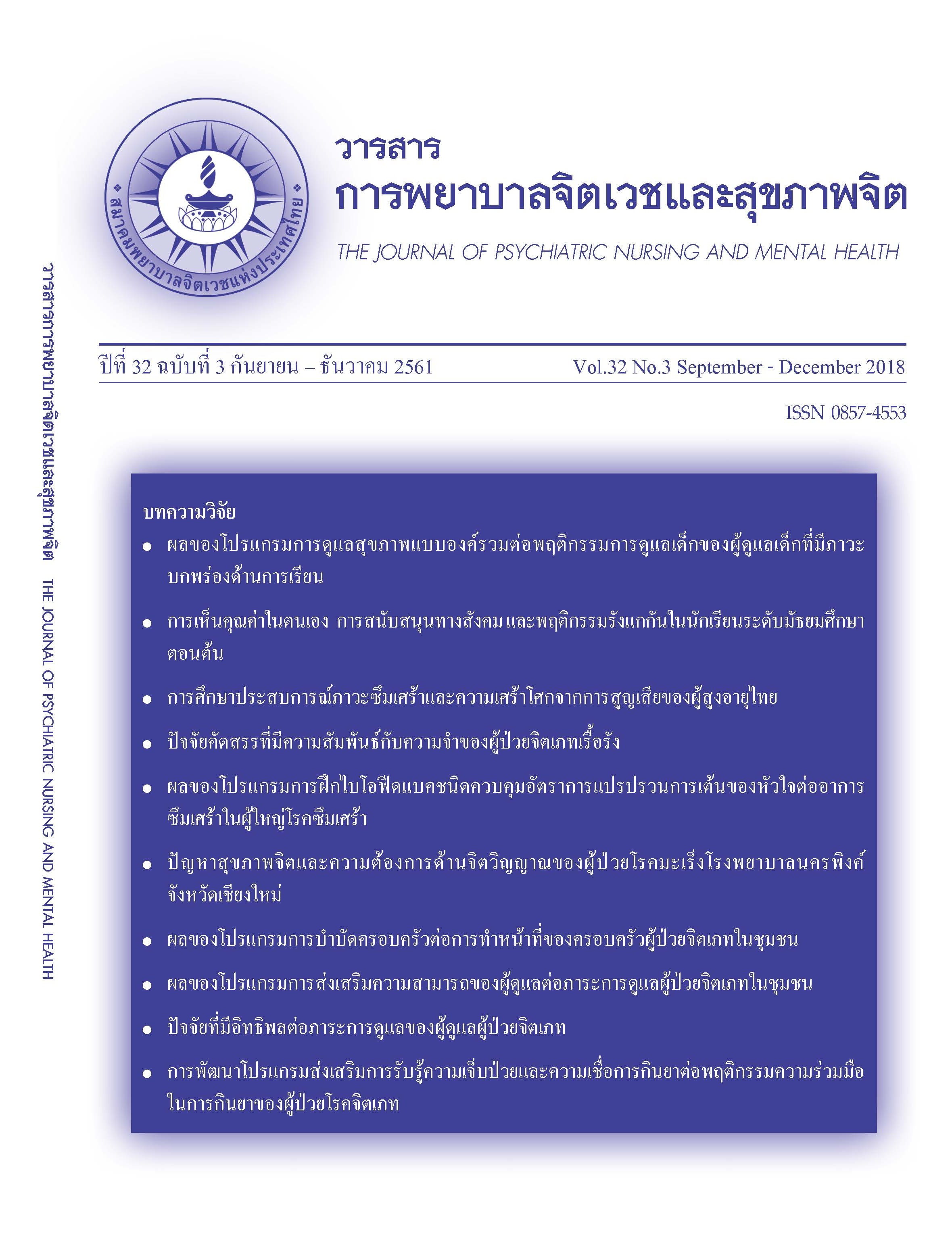ปัจจัยคัดสรรที่มีความสัมพันธ์กับความจำของผู้ป่วยจิตเภทเรื้อรัง
Main Article Content
บทคัดย่อ
บทคัดย่อ
วัตถุประสงค์: การวิจัยเชิงบรรยายครั้งนี้มีวัตถุประสงค์เพื่อศึกษาความสัมพันธ์ระหว่างอายุ เพศ ระยะเวลาการเจ็บป่วย อาการทางบวกและอาการทางลบ การปฏิบัติกิจวัตรประจำวันความเครียด การใช้สารเสพติด กับความจำของผู้ป่วยจิตเภทเรื้อรัง
วิธีการศึกษา: กลุ่มตัวอย่างคือ ผู้ป่วยโรคจิตเภทจำนวน 154 คน ที่ได้รับการวินิจฉัยจากแพทย์ว่าเป็นโรคจิตเภทเรื้อรังตามเกณฑ์การวินิจฉัยของระบบการจำแนกโรคขององค์การอนามัยโลก ที่มารับการรักษาแบบผู้ป่วยนอกและในที่สถาบันจิตเวชศาสตร์สมเด็จเจ้าพระยา ซึ่งได้รับการคัดเลือกตามคุณสมบัติและยินดีให้ความร่วมมือในการวิจัยเครื่องมือที่ใช้ในการวิจัย คือ 1) แบบประเมินสมรรถภาพสมองฉบับภาษาไทย2) แบบประเมินและวิเคราะห์ความเครียดด้วยตนเอง 3) แบบวัดระดับความรุนแรงของอาการทางบวกและทางลบของโรคจิตเภท และ4) แบบประเมินการปฏิบัติกิจวัตรประจำวัน เครื่องมือทุกชุดได้ผ่านการพิจารณาความตรงเชิงเนื้อหาโดยผู้ทรงคุณวุฒิ 5 ท่าน มีค่าความเที่ยงสัมประสิทธิ์แอลฟาของครอนบาค เท่ากับ 0.82, 0.85, 0.92,และ 0.78 ตามลำดับ สถิติที่ใช้วิเคราะห์ข้อมูล ได้แก่ค่าร้อยละ ค่าเฉลี่ย ส่วนเบี่ยงเบนมาตรฐาน สถิติทดสอบที และสัมประสิทธิ์สหสัมพันธ์เพียร์สัน
ผลการศึกษา:
1. ความจำของผู้ป่วยจิตเภทเรื้อรังอยู่ในระดับปานกลาง (Mean = 20.6, S.D. = 4.08) 2. ระยะเวลาการเจ็บป่วย ความเครียดอาการทางบวกและอาการทางลบ มีความสัมพันธ์ทางลบกับความจำในผู้ป่วยจิตเภทเรื้อรังอย่างมีนัยสำคัญทางสถิติที่ระดับ .05 (r = - .54, -.34, -.50และ-.45 ตามลำดับ) 3. อายุ เพศ การปฏิบัติกิจวัตรประจำวันการใช้สารเสพติด ไม่มีความสัมพันธ์กับความจำในผู้ป่วย จิตเภทเรื้อรัง
Article Details
บทความที่ได้รับการตีพิมพ์แล้ว เป็นลิขสิทธิ์ของสมาคมพยาบาลจิตเวชแห่งประเทศไทย
เอกสารอ้างอิง
ธนา นิลชัยโกวิทย์ และคณะ. (2550). Positive and negative syndrome scale ฉบับภาษาไทย (PANSS-T). กรมสุขภาพจิต กระทรวงสาธารณสุข.
พิชานันท์ ลีแก้ว. (2556). การดื่มกาแฟกับสุขภาพ. เข้าถึงเมื่อ 12 ธันวาคม, 2556, จาก https://www.pharmacy. mahidol.ac.th/thai/knowledgeinfo.php?id=180
พิเชษฐ์ อุดมรัตน์ และสรยุทธ วาสิกนานนท์. (2552). ตำราโรคจิตเภท. กรุงเทพฯ: สมาคมจิตแพทย์แห่งประเทศไทย.
มาโนช หล่อตระกูล และปราโมทย์ สุคนิชย์. (2555). จิตเวชศาสตร์รามาธิบดี. (พิมพ์ครั้งที่ 2). กรุงเทพฯ: บียอนด์ เอ็นเตอร์
ไพซ์ รัตน์ศิริ ทาโต. (2552). การวิจัยทางการพยาบาลศาสตร์แนวคิดสู่การประยุกต์ใช้ (พิมพ์ครั้งที่ 2). กรุงเทพฯ: จุฬาลงกรณ์มหาวิทยาลัย.
วนาพร หลอยกร. (2542). ปัจจัยที่มีความสัมพันธ์กับภาวะสมองเสื่อมของผู้สูงอายุในจังหวัดกาญจนบุรี. วิทยานิพนธ์ปริญญาพยาบาลศาสตร์มหาบัณฑิต สาขาการพยาบาลผู้สูงอายุ, บัณฑิตวิทยาลัย, มหาวิทยาลัยบูรพา.
สมภพ เรืองตระกูล. (2553). ตำราจิตเวชศาสตร์พื้นฐานและโรคทางจิตเวช (พิมพ์ครั้งที่ 2). กรุงเทพมหานคร: เรือนแก้วการพิมพ์.
Aleman, A., Hijman, R., de Haan, E. H., & Kahn, R. S. (1999). Memory impairment in schizophrenia: A meta-analysis. American Journal of Psychiatry, 156(9), 1358-1366. doi:10.1176/ajp.156.9.1358
Atkinson, R. C., & Shiffrin, R. M. (1977). Memory and cognition. In S. Worchel & W. Shebilsk (Eds.), Psychology principles and application. New Jersey: Prentice Hall.
Benaiges, I., Prat, G., & Adan, A. (2012). Health-related quality of life in patients with dual diagnosis: Clinical correlates. Health and Quality of Life Outcomes, 10, 106-128.
Ciocon, J. O., & Potter, J. F. (1988). Age-related changes in human memory: Normal and abnormal. Geriatrics, 43(10), 43-48.
Eaton, W. W., & Mcleod, J. (1984). Consumption of coffee or tea and symptoms of anxiety. American Journal Public Health, 74, 66-68.
Fisone, G., Borgkvist, A., & Usiello, A. (2004). Review caffeine as a psychomotor stimulant: Mechanism of action. Cellular and Molecular Life Science, 61, 857-872.
Garcia, L. E., Castillon, G. P., Munoz, L. L., Graciani, A., & Artalejo, R. F. (2014). Coffee consumption and health-related quality of life. Clinical Nutrition, 33, 143-149.
Goldman-Rakic, P. S. (1992). The working memory. Scientific American, 267(3), 110–118.
Gur, A. Y., Gücüyener, D., Korczyn, A. D., Üzüner, N., Gilutz, Y., Özdemir, G., et al. (2010). Cerebral vasomotor reactivity and dementia after ischemic stroke. Acta Neurologica Scandinavica, 122(6), 383-388. doi:doi:10.1111/j.1600-0404.2010.01323.x
Hausmann, A., & Fleischhacker, W. W. (2002). Differential diagnosis of depressed mood in patients with Schizophrenia: a diagnostic algorithm based on a review. Acta Psychiatrica Scandinavica, 106, 83-96.
Hasher, L., & Zacks, R. T. (1998). Working memory dysfunction and its relevance to schizophrenia. In G. Bower (Ed.), The psychology of learning and motivation. New York: Academic Press.
Herbener, E. S., Rosen, C., Khine, T., & Sweeney, J. A. (2007). Failure of positive but not negative emotional valence to enhance memory in schizophrenia. Journal Abnormal Psychological, 116(1), 43-55
Keltner, N. L., & Johnson, V. (2002). Biological Perspectives. Perspectives in Psychiatric Care, 38(4), 157-159.doi:10.1111/j. 1744-6163.2002.tb01566.x
Klapow, J. C., Evans, J., Patterson, T. L., Heaton, R. K., Koch, W. L., & Jeste, D. V. (1997). Direct assessment of functional status in older patients with schizophrenia. American Journal of Psychiatry, 154(7), 1022-1024. doi:10. 1176/ajp.154.7.1022
Landgraf, S., Steingen, J., Eppert, Y., Niedermeyer, U., van der Meer, E., & Krueger, F. (2011). Temporal information processing in shortand long-term memory of patients with schizophrenia. Public Library of Science One, 6(10), 1-9. doi:10.1371/journal.pone.0026140
McDougall, G. J. (2002a). Memory improvement in assisted living elders. Mental Health Nursing, 21, 217-233. McDougall, G. J. (2002b). Memory improvement in octogenarians. Applied Nursing Research, 15, 2-10.
McDermid Vaz, S. A., & Heinrichs, R. W. (2002). Schizophrenia and memory impairment: Evidence for a neurocognitive subtype. Psychiatry Research, 113(1-2), 93-105.
Meissner, C. A., & Brigham, J. C. (2001). Thirty years of investigating the own-race bias in memory for faces: A meta-analytic review. Psychology, Public Policy, and Law, 7(1), 3-35.
Nikolova, R., Demers, L., & Veland, S. (2007). Trajectories of Cognitive and Functional status in the frail order adults. Achieves of Gerontology and Geriatric, 14, 1-4.
Park, S., & Holzman, P. S. (1992). Schizophrenics show spatial working memory deficits. Archives of General Psychiatry, 49(12), 975-982.
Ragland, J. D., Yoon, J., Minzenberg, M. J., & Carter, C. S. (2007). Neuroimaging of cognitive disability in schizophrenia: Search for a pathophysiological mechanism. International review of psychiatry, 19(4), 417-427. doi:10.1080/09540260701486365
Ritch, J. L., Velligan, D. I., Tucker, D., Dicocco, M., & Maples, N. J. (2003). Prospective memory in schizophrenia. Schizophrenia Research, 60(1), 180.
Stip, E., & Lussier, I. (1996). The Heterogeneity of Memory Dysfunction in Schizophrenia. The Canadian Journal of Psychiatry, 41(7), 14-20. doi:10.1177/070674379604100703
Tek, C., Kirkpatrick, B., & Buchanan, R. W. (2001). A five-year follow up study of deficit and non-deficit schizophrenia. Schizophrenia Research, 49(3), 253-260.
World Health Organization. (2011). World report on disability. Retrieved April 25, 2016, from https://www.who.int/ disabilities/world_report/2011/report/en/


